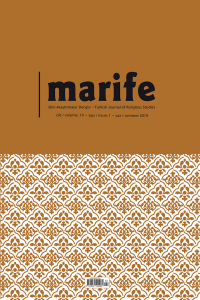
Marife Dini Araştırmalar Dergisi
Yazarlar: Mesut CAN
Konular:Tarih
DOI:10.33420/marife.904735
Anahtar Kelimeler:Islamic History,Serakhs,Central Asia,Islamization,Islamic City
Özet: According to the account of Yāḳūt al-Ḥamawī in his geography work, Serakhs was built during the Achaemenid Empire (559-330 BC), in the name of Serhas I, the son of Dārā I, who took the throne after Kay Kāʾūs. Therefore, it got its name from this Persian ruler. The available archaeological data reveal as well that the city was founded during the time of the Ahemenids. The Old Serakhs is located in Southern Turkmenistan, on the right bank of Tedjen River, which constitutes a natural border between Iran and Turkmenistan, in an oasis formed by the lower branches fed by a tributary from the river. Archaeological data also reveal that Serakhs was located at the distribution point of the river tributaries feeding the Iron Age settlements of the oasis. For this reason, it can be said that the city was the administrative center of the oasis from the beginning. Muslim geography authors point out in their works that the rural settlement of Serakhs was quite low and they record two sub-districts, one rustāq and twenty-four villages. Located between Marw and Nīs̲h̲āpūr, two of the major cities and also regions of K̲h̲urāsān, Serakhs was accepted as a part of the Marw region by the early geographical sources. Serakhs was conquered by many empires before the Muslims came to these lands. First, the city was conquered by the Greek-Macedonian king Alexander the Great on his eastern expedition, and probably then passed under the rule of Seleucids after his death. It remained once under the rule of the Parthians, then possibly the White Huns, and the Sāsānids for the last four centuries. After the collapse of Sāsānid Empire in the first wave of conquest in the time of ʿUmar (I) b. al-K̲h̲aṭṭāb, it was conquered peacefully by ʿAbd Allāh b. ʿĀmir during the conquests of K̲h̲urāsān in ʿUt̲h̲mān’s time and joined Islamic lands. It can be said that there was a relatively peaceful and stable period in Serakhs under the Umayyad and ʿAbbāsid (including Ṭāhirids) rule. However after the Ṭāhirids, it is seen that there were struggles between the Sāmānids, G̲h̲aznavids and Sald̲j̲ūḳids in the region. Having achieved a decisive victory in the Dandānḳān War (431/1040), Sald̲j̲ūḳids ruled Serakhs for a long time. Especially the era of Sultan Sand̲j̲ar is a time when Serakhs developed in material, scientific and cultural terms. Under the Muslim administration, it is seen that Serakhs experienced a great change in both physical and sociocultural structure. The most radical change in the physical structure of the city is that rabad became part of the city topography as in other cities in K̲h̲urāsān. Although Islamic geographers did not point to a Kuhandiz, the architectural structure so-called Serakhs Castle was the Kuhandiz. Thus, it is understood that Serahs has a triple city typology of Kuhandiz, s̲h̲ahristān and rabad. Perhaps more important than the physical change of the city was that Muslim Arabs, hence Islam, began to play a role in the social life of the city. It can be said that especially the moderate policy followed against Mawālī contributed to Islamization in Serakhs during the ʿAbbāsid period. As a matter of fact, al-Faḍl b. Sahl converted to İslam in time of al-Maʾmūn and managed to rise to the rank of vizier. We can say that Islamization continued at the same pace in the era of Ṭāhirids, Sāmānids and G̲h̲aznavids, giving rise to islam almost dominating the region during the arrival of Sald̲j̲ūḳids. One of the most important consequences of Sald̲j̲ūḳid domination in the region (426/1035) is undoubtedly the settlements of Turks. Since that time, it has been witnessed that the influence of other ethnic and cultural elements in the region has decreased and traces of Turkish communities and culture have become permanent. As in all K̲h̲urāsān, the effects of Mongolian invasion (1221) in Serakhs were devastating, so the city could not return to its glorious days despite the development activities during the Tīmūrid period.
Dergi editörleri editör girişini kullanarak sisteme giriş yapabilirler. Editör girişi için tıklayınız.